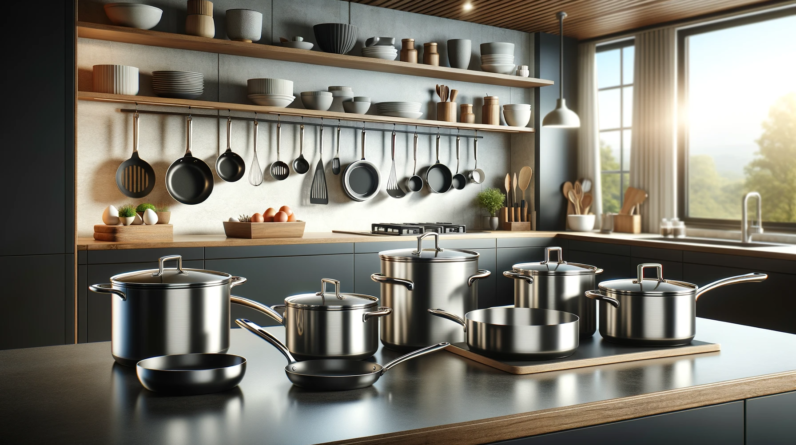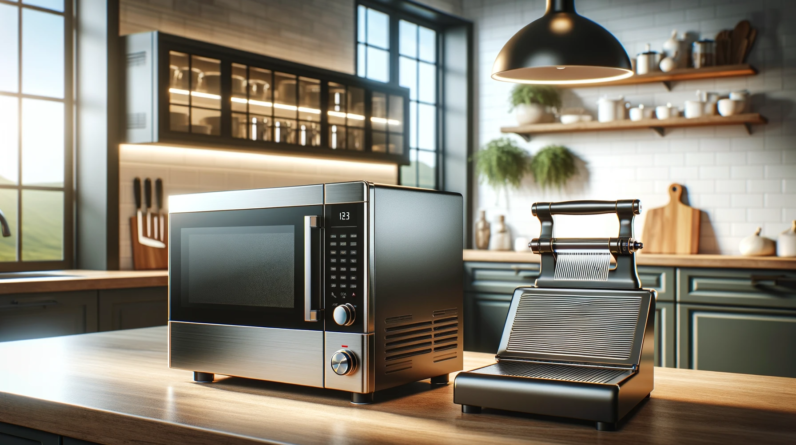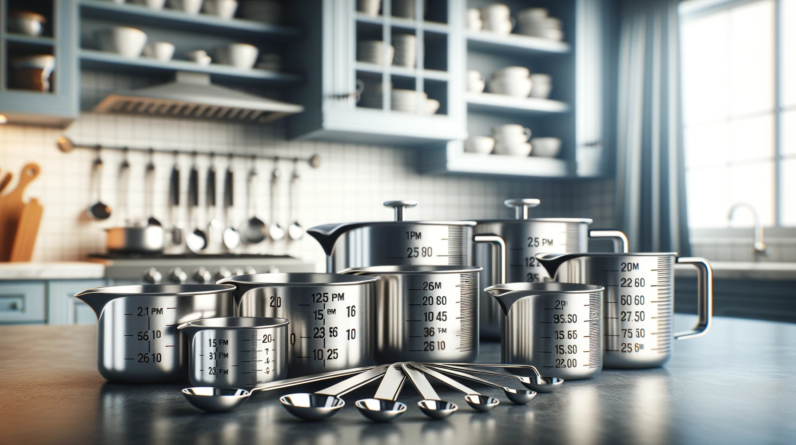
Disclaimer: This post may contain affiliate links. As an Amazon Associate, we earn from qualifying purchases.
In your quest for healthier cooking, choosing the right utensil is a crucial step towards achieving your goal. With an abundance of options available, it can be overwhelming to determine which utensil is truly the best. However, fear not, as we delve into the world of healthy cooking and guide you towards the ultimate utensil that will revolutionize your culinary experience.
From non-stick pans to silicone spatulas and beyond, discover the key to creating nutritious and delicious meals in this enlightening Post. When it comes to healthy cooking, using the right utensils can make a significant difference.
Not only does it enhance the cooking experience, but it also has a great impact on the quality and nutritional value of your meals. In this article, we will explore the benefits of using the right utensil for healthy cooking, discuss the different types of utensils available, compare their features, and provide expert recommendations to help you make the best choices.
So, let’s dive in and discover the world of utensils that can transform your cooking into a healthier and more enjoyable experience.
Benefits of Using the Right Utensil for Healthy Cooking
Retaining Nutrients in Food
 One of the key benefits of using the right utensil for healthy cooking is the retention of nutrients in your food. Different utensils have varying levels of heat conductivity, which directly affects how nutrients are preserved during the cooking process.
One of the key benefits of using the right utensil for healthy cooking is the retention of nutrients in your food. Different utensils have varying levels of heat conductivity, which directly affects how nutrients are preserved during the cooking process.
Using utensils that distribute heat evenly helps maintain the nutritional integrity of your ingredients, ensuring that vitamins, minerals, and antioxidants are not lost due to excessive heat exposure. By choosing the right utensil, you can ensure that your meals are not only delicious but also packed with essential nutrients.
Cooking Food Evenly
Have you ever had a dish where some parts were undercooked while others were overcooked? Uneven cooking can be a real challenge, especially when aiming for healthy and flavorful results. Using the right utensil can help overcome this issue by promoting even heat distribution.
Utensils with excellent heat conductivity and uniform heat distribution help your food to cook consistently throughout, preventing any overcooked or undercooked areas. This ensures that you achieve the perfect texture, flavor, and doneness, making your meals both aesthetically pleasing and delicious.
Non-Toxic and Safe Cooking
 When it comes to healthy cooking, it’s essential to consider the safety of the utensils you use. Some materials used in cookware and utensils can potentially leach harmful chemicals into your food, compromising its nutritional value. By selecting non-toxic and safe utensils, you can eliminate this concern and cook your meals with peace of mind.
When it comes to healthy cooking, it’s essential to consider the safety of the utensils you use. Some materials used in cookware and utensils can potentially leach harmful chemicals into your food, compromising its nutritional value. By selecting non-toxic and safe utensils, you can eliminate this concern and cook your meals with peace of mind.
Using utensils made from high-quality and food-safe materials ensures that no harmful substances seep into your food, allowing you to maintain the integrity of your ingredients and make truly healthy meals.
Reducing Oil Usage
Healthy cooking often involves reducing the amount of oil used in preparing meals. Excessive oil consumption can lead to health issues such as weight gain and heart problems. Using the right utensil can help minimize the need for oil while still achieving the desired cooking results.
 Certain utensils, such as non-stick pans, ceramic cookware, and silicone spatulas, allow you to cook with minimal oil or even without it. By choosing utensils that promote non-stick properties, you can enjoy delicious and healthy meals with reduced oil usage, making it easier to maintain a balanced and nutritious diet.
Certain utensils, such as non-stick pans, ceramic cookware, and silicone spatulas, allow you to cook with minimal oil or even without it. By choosing utensils that promote non-stick properties, you can enjoy delicious and healthy meals with reduced oil usage, making it easier to maintain a balanced and nutritious diet.
Different Types of Utensils for Healthy Cooking
Now that we have explored the benefits of using the right utensil, let’s delve into the different types of utensils available for healthy cooking. Each type of utensil has its unique features, advantages, and considerations. Understanding these differences can help you make informed decisions when selecting utensils for your kitchen.
Stainless Steel Utensils
Stainless steel utensils are a popular choice for healthy cooking due to their durability, heat conductivity, and non-reactive nature. They are resistant to rust, corrosion, and staining, making them long-lasting and easy to maintain. Stainless steel utensils are ideal for various cooking methods, including sautéing, frying, boiling, and simmering.
Moreover, they do not react with acidic or alkaline ingredients, ensuring that the taste and nutritional value of your food remain intact.
Cast Iron Utensils
Cast iron utensils are renowned for their exceptional heat retention and distribution properties. They excel in searing, browning, and slow cooking, making them ideal for dishes that require intense heat and extended periods of cooking. Cast iron utensils also provide a natural non-stick surface when properly seasoned, reducing the need for excessive oil.
Additionally, cooking with cast iron can increase the iron content in your food, which is beneficial for individuals with iron deficiency.
Ceramic Utensils
Ceramic utensils have gained popularity in recent years due to their non-toxic and non-reactive properties. They are free from harmful chemicals such as PFOA and PTFE commonly found in traditional non-stick coatings. Ceramic utensils distribute heat evenly and retain moisture, allowing for gentle and efficient cooking.
They are versatile and can be used in various cooking methods, including baking, roasting, and braising. However, ceramic utensils may be prone to chipping or cracking if not handled with care.
Non-stick Utensils
Non-stick utensils are incredibly convenient for healthy cooking, as they require minimal oil and prevent food from sticking to the surface. They are usually made with a non-stick coating, such as Teflon, which allows for easy food release and effortless cleaning. Non-stick utensils are suitable for low-fat cooking methods like sautéing, stir-frying, and scrambling eggs. However, it’s important to note that the non-stick coating can wear off over time and may not be suitable for high-heat cooking or metal utensils that can scratch the surface.
Silicone Utensils
 Silicone utensils have gained popularity for their flexibility, heat resistance, and non-scratch properties. They are made from a synthetic material that can withstand high temperatures without melting or warping. Silicone utensils are ideal for non-stick cookware, as they are gentle on the surface and prevent scratching.
Silicone utensils have gained popularity for their flexibility, heat resistance, and non-scratch properties. They are made from a synthetic material that can withstand high temperatures without melting or warping. Silicone utensils are ideal for non-stick cookware, as they are gentle on the surface and prevent scratching.
They are commonly used for mixing, stirring, flipping, and scraping ingredients.
Silicone utensils are also easy to clean, dishwasher-safe, and hygienic, making them a convenient choice for healthy cooking.
Comparison of Utensils for Healthy Cooking
Now that we have explored the various types of utensils for healthy cooking, it’s essential to compare their features to help you make an informed decision. Here are several factors to consider when comparing utensils:
Heat Conductivity
Heat conductivity determines how evenly heat is distributed throughout the utensil’s surface. Utensils with excellent heat conductivity promote uniform cooking and prevent hotspots. Materials such as stainless steel and copper have high heat conductivity, while others, like silicone, have lower heat conductivity.
Consider your cooking preferences and the desired cooking outcomes when selecting utensils with the appropriate heat conductivity.
Durability
Durability is an important factor when investing in utensils for healthy cooking. Longevity ensures that you can enjoy using your utensils for years to come without worrying about wear and tear. Materials like stainless steel and cast iron are known for their durability, while others, like ceramic, may require careful handling to avoid breakage.
Assessing the durability of utensils can help you make a sustainable and cost-effective choice for your kitchen.
Non-Stick Properties
Non-stick properties are desirable for healthy cooking, as they allow for lesser oil usage and easier food release. Utensils like non-stick pans and silicone spatulas excel in providing a non-stick cooking surface. However, it’s important to consider the quality and longevity of the non-stick coating, as it can deteriorate over time.
Evaluating the non-stick properties of utensils can help you achieve healthier cooking results without compromising on taste or texture.
Maintenance and Care
Different utensils require varying levels of maintenance and care. Some materials may require special cleaning techniques or specific utensils to prevent scratching. Consider the ease of cleaning and maintenance requirements when selecting utensils for your kitchen.
Utensils that are dishwasher-safe or have non-reactive properties make cleaning and maintenance effortless, saving you time and effort in the long run.
The Best Utensil for Healthy Cooking: Expert Recommendations
With a wide array of utensils available for healthy cooking, it can be overwhelming to choose the best ones for your kitchen. To help you make an informed decision, here are several expert recommendations for the best utensils:
1. Chef’s Knife
A high-quality chef’s knife is an essential tool in every kitchen. It allows for precise and efficient cutting, chopping, and slicing of ingredients. Investing in a durable and well-balanced chef’s knife can enhance your cooking experience and make meal preparation a breeze.
2. Stainless Steel Skillet
A stainless steel skillet is a versatile utensil suitable for various cooking methods. It promotes even heat distribution and is ideal for sautéing, frying, and browning. Look for a skillet with a sturdy handle and a tight-fitting lid for added convenience.
3. Cast Iron Pan
 Cast iron pans are excellent for searing, slow cooking, and baking. They provide exceptional heat retention and distribution, creating delicious, evenly cooked meals. An enameled cast iron pan offers a non-reactive cooking surface with added durability and easy maintenance.
Cast iron pans are excellent for searing, slow cooking, and baking. They provide exceptional heat retention and distribution, creating delicious, evenly cooked meals. An enameled cast iron pan offers a non-reactive cooking surface with added durability and easy maintenance.
4. Baking Sheet
A baking sheet is a must-have utensil for healthy cooking enthusiasts. It is perfect for roasting vegetables, baking cookies, and making sheet pan meals.
Look for a baking sheet with a non-stick coating or opt for a silicone baking mat for easier food release.
5. Steamer Basket
A steamer basket is a fantastic utensil for preserving the nutrients in your food while maintaining its natural flavors. It allows for gentle and healthy cooking by steaming vegetables, fish, and poultry. Look for a steamer basket that fits your existing pots and pans for added convenience.
6. Silicone Spatula
A silicone spatula is a versatile tool that can withstand high temperatures without melting or scratching your cookware. It is ideal for stirring, mixing, scraping, and flipping ingredients. Look for a silicone spatula with a sturdy handle and a heat-resistant head for safe and efficient cooking.
7. Bamboo Cutting Board
A bamboo cutting board is an eco-friendly and hygienic option for your kitchen. It is durable, knife-friendly, and resistant to stains and odors. Opt for a bamboo cutting board with a groove to catch juices, minimizing mess during food preparation.
8. Stainless Steel Mixing Bowls
Stainless steel mixing bowls are versatile and durable utensils suitable for various cooking and baking needs. They are non-reactive, easy to clean, and can withstand high temperatures. Look for a set of mixing bowls in different sizes to accommodate your diverse culinary endeavors.
9. Whisk
A whisk is an indispensable tool for whipping, blending, and emulsifying ingredients. It helps create fluffy eggs, smooth sauces, and light batters. Look for a whisk with sturdy wires and a comfortable handle for effortless mixing.
10. Salad Spinner
A salad spinner is a fantastic utensil for washing and drying leafy greens and herbs. It removes excess water, ensuring that your salads are fresh and crisp. Look for a salad spinner with a durable construction and an easy-to-use mechanism.
Tips for Choosing the Right Utensil
Now that we have covered the benefits, types, and expert recommendations for utensils, let’s explore some tips for choosing the right utensil for healthy cooking:
1. Consider the Cooking Method
Different cooking methods require specific utensils. Assess your cooking preferences and the recipes you frequently prepare to determine the most suitable utensils for your needs. For example, if you enjoy baking, investing in a high-quality baking sheet and mixing bowls would be a wise choice.
2. Evaluate Heat Conductivity
Consider the heat conductivity of the utensils you are considering. Utensils with excellent heat conductivity, such as stainless steel and copper, promote even cooking, minimizing the risk of unevenly cooked dishes. Evaluate your cooking style and the desired cooking outcomes to select utensils with appropriate heat conductivity.
3. Assess Durability and Longevity
Durability is an essential factor to consider when choosing utensils. Assess the materials and construction of the utensils to ensure that they can withstand regular use and last for a long time. Investing in durable utensils not only saves you money in the long run but also allows for consistent and reliable performance.
4. Check for Non-Stick Properties
If reducing oil usage and preventing food from sticking are important to you, consider utensils with non-stick properties. Utensils like non-stick pans and silicone spatulas provide convenience and make healthy cooking easier. However, prioritize quality and longevity when selecting utensils with non-stick coatings.
5. Consider Maintenance and Ease of Cleaning
 Assess the cleaning and maintenance requirements of the utensils you are considering. Utensils that are dishwasher-safe or easy to clean by hand can save you time and effort. Non-reactive and stain-resistant materials are also desirable, as they make maintenance more manageable and ensure that your utensils stay in pristine condition.
Assess the cleaning and maintenance requirements of the utensils you are considering. Utensils that are dishwasher-safe or easy to clean by hand can save you time and effort. Non-reactive and stain-resistant materials are also desirable, as they make maintenance more manageable and ensure that your utensils stay in pristine condition.
Conclusion
Choosing the right utensil for healthy cooking can have a substantial impact on the quality, taste, and nutritional value of your meals.
By selecting utensils that retain nutrients, promote even cooking, ensure safety, and reduce oil usage, you can transform your cooking into a healthier and more enjoyable experience.
Consider the different types of utensils available, compare their features, and make informed decisions based on your cooking preferences and needs. With expert recommendations and helpful tips, you are well-equipped to create delicious and nutritious meals while embracing the joy of healthy cooking.





